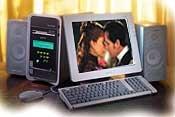The Cutting Edge: Sony MXS10 Vaio PC

At $2,800, the least expensive Vaio PC in Sony's MX desktop line doesn't seem like much of a bargain these days, even for a 1.7-GHz, Pentium 4 with an 80-gigabyte (GB) hard drive, 512 megabytes (MB) of memory, the exciting "home" version of Windows XP, and two better-than-average speakers (the 15-inch Sony LCD monitor shown is $600 extra). But the PCV-MXS10 that I tested - the various MX models differ only in the bundled home-office software - is much more than just a powerful PC. Of course, it does all the usual computer stuff like word processing, Web browsing, receiving streaming media, and editing digital photos (a task eased for Sony cameras by a Memory Stick slot). But using only the built-in hardware and the supplied software, the MXS10 can also serve many other roles, such as that of a personal video recorder.
Sony's Giga Pocket software, together with the PC's internal 130-channel stereo TV tuner and ample hard drive (up to 60 GB of which is available for video data), enables the MXS10 to provide many of the functions of a TiVo or ReplayTV hard-disk video recorder. These include timer recording at three quality levels, which correspond to degrees of data compression; playback of a point earlier in the program currently being recorded (using Slip Play) or of a previously recorded program; and recording non-copy-protected composite- or S-video signals from an external source. There's an Internet-based program guide that can be used for point-and-click recording setup, and you can watch your recordings either on the computer's monitor or on a TV via the MXS10's interlaced NTSC-video outputs. Many of the Giga Pocket functions are accessible through the supplied infrared remote.
Surpassing all standalone hard-disk recorders in versatility, Giga Pocket and the MXS19 also let you, for instance, edit out all the commercials from a recorded program, but your editing needn't stop there (more on this below). You can permanently store the edited results on disc using the built-in DVD recorder, a combination DVD-R/RW drive that's the computer's only optical-disc drive.
You can "burn" edited video programs or homemade video productions onto write-once DVD-Rs that can be played on most standalone players. You can make "practice" discs by recording first onto rewritable DVD-RW blanks and then duplicate your fine-tuned production, as many times as you like, using the much cheaper DVD-R blanks. If you limit your productions to around 7 minutes - all home movies should be edited down to 7 minutes anyway - you can even record in DVD format on dirt-cheap CD-Rs that will play in many computer DVD-ROM drives (but not in standalone players).
- Log in or register to post comments























































